Criminal court statistics quarterly: July to September 2024
Published 12 December 2024
Applies to England and Wales
Main Points
| Magistrates’ court: open caseload increased | Case receipts volumes at the magistrates’ courts continue to outstrip disposals - true for each of the last six quarters. As a result, the open caseload continued to increase, up 22% on the previous year to 333,349. |
| Crown Court: open caseload increased | Receipts continued to increase and reached a quarterly peak since 2016. Disposal volumes have increased but they remain below receipts. As a result, the open caseload continued to increase and reached a series peak of 73,105. |
| Crown Court: small fall in average age of open case | The median age of open cases and number of cases open for a year or more both fell slightly compared to the previous year. |
| Ineffective trial rates remain stable | The ineffective trial rate at both the magistrates’ courts (22%) and Crown Court (25%) have settled at higher than before the COVID pandemic. |
| Timeliness for magistrates’ court cases remained high | The median time from offence to completion at the magistrates’ court was stable on the previous quarter - estimates remain above pre-COVID levels. |
| Timeliness for Crown Court cases remained high | The median time from offence to completion at the Crown Court fell on the previous quarter – estimates remain well above pre-COVID levels. |
The technical guide to ‘Criminal court statistics’ and ‘Language interpreter and translation services in courts and tribunals’ can be found at the links below:
https://www.gov.uk/government/publications/a-guide-to-criminal-court-statistics
Statistician’s comment
This report covers the period to the end of September 2024.
This is the first release of data since March 2024 and comes as a result of necessary changes made to systems used for processing court data which have enabled robust and accurate data to be produced. In addition, an external assurance review of the process and methods concluded that “MoJ could have significant confidence in the Crown Court caseload statistics” which are published here.
We have taken the opportunity since the last publication to improve our Crown Court caseload methodology and align HMCTS and MoJ methodologies via the “One Crown” project. The published data concerning the Crown Court caseload, and the age of open cases comes from “One Crown”, while we will move all other measures across iteratively as we review methods and refine our approach to ensure we release robust, trustworthy and high value data. The overall impact on the open caseload in these statistics is relatively small, and the technical guide explains that in more detail.
The demand on the criminal courts continues to increase with receipt volumes increasing at both the magistrates’ courts and the Crown Court, with the latest receipt volumes at the Crown Court representing a series peak since 2016.
Disposals volumes remained below receipts at both courts and as such the open caseload has continued to increase. At the Crown Court the open caseload continued to report a series peak, reaching 73,105 cases at the end of September 2024.
Both trial ineffective rates and average timeliness estimates remain historically high – these measures have tended to fall back from series peaks but have stabilised at levels well above those seen prior to 2020.
1. Changes to note
Data quality update
In June and September, we notified users of the cancellation of the Criminal Court Statistics quarterly (CCSQ) publication, highlighting work that was necessary to assure the quality of source data for the key series in both the Ministry of Justice (MoJ) Accredited Official Statistics and HM Courts and Tribunals Service (HMCTS) management information (MI).
That initial work highlighted some necessary changes to court processing systems to enable robust and accurate data to be produced.
This work has been completed and we have worked with HMCTS analytical and operational teams to resolve the identified quality issues.
Additionally, the Lord Chancellor requested that an independent, external assurance review of the process and methods used to produce Crown Court caseload statistics took place. The review concluded that the MoJ can have a significant level of confidence in the Crown Court caseload statistics.
In parallel to this review the Office for Statistics Regulation (OSR) are currently carrying out a data quality check on the criminal court statistics quarterly release. We will work with the OSR to take forward an action plan to carry forward any requirements and recommendations once the final report is available, expected in early 2025.
These issues did not affect the operation of the courts and were purely an issue for the data reporting.
Full details of the impacts of the data quality work on published estimates is available alongside this report and can be found in Crown Court Data Quality update.
One Crown consultation
We are taking the opportunity to make changes to improve the definitions, methodologies and transparency used for the Crown Court statistics published in this release.
The data quality improvement work on these statistics has been implemented alongside work to align the MoJ Accredited Official Statistics and HMCTS MI methodologies - benefitting users by providing greater transparency and coherence in court data.
To address the previous differences in the HMCTS and MoJ datasets, we have worked together on a project - the One Crown Court Data project - to create a single, consistent and flexible dataset that meets both MoJ and HMCTS needs. This will bring greater transparency, clarity and coherence for all users.
There are a small number of relatively small changes to the methodology used to produce data in this publication to define a Crown Court case as being received, disposed or open.
In part, the changes seek to align more closely with the way that cases are treated operationally and how court users will see the case in the Common Platform case management system. These changes also ensure that we maintain an accurate and robust timeseries with the ‘legacy’ systems.
The Crown Court caseload data series (receipts, disposals and open cases) and estimates of the age of the open caseload published here use the “One Crown” caseload definitions. All other published metrics retain the existing methodology here, though we are looking to update them in the future.
The proposed alignment of definitions runs beyond just caseload estimates and looks to harmonise our approach to all published Crown Court performance measures as well as key breakdowns and categorisation used.
We will continue to regularly review the presentation and breakdown of Crown Court measures ahead of a fuller release of the improved approach for additional measures in March 2025 and throughout future editions of the statistics release. Full details of the changes and estimated impacts on caseload statistics including comparisons to the previous methodology are available alongside this report and can be found in Consultation on “One Crown” changes to the Crown Court data processing in Criminal Court statistics quarterly (CCSQ).
Changes to magistrates’ open caseload estimates
The magistrates’ caseload data presented in this release has been substantially revised following work that HMCTS have undertaken on a transformation programme to modernise its data and management information (MI).
During this work, HMCTS found evidence that the magistrates’ courts open caseload data is significantly overstated. This is due to a variety of issues identified in the data derived from the legacy case management system, Libra.
The latest published criminal only open caseload estimate has been revised down by around 80,000 cases which represents around 20% of the total reported criminal open caseload.
This discrepancy is due to a data archiving process (originally built around 2010), which archived inactive cases from Libra to a historic register according to an agreed data retention schedule. Archived cases are those which to all intents and purposes are no longer live or requiring any positive action from the court, but which technically lack a final disposal code. The system used to extract this MI (Libra MIS) does not have the same archiving requirement and therefore did not recognise the archived cases as closed. This only affects less than 1% of cases ever entered into Libra, but the scale of the magistrates’ courts caseload and the length of time over which this has accumulated has resulted in the volume being relatively high.
There are a small number of additional cohorts of legacy cases that are being investigated for remedial action and the data published here is subject to future revision. It is anticipated that these additional changes will lead to a downwards revision of around 20,000-30,000 cases. Ongoing data quality improvement work by HMCTS may result in further changes that we will alert users to in future publications.
Cessation of unlinked Crown Court timeliness estimates
We have removed the “unlinked” Crown Court timeliness estimates from this release. The unlinked measures were developed to meet user needs while the linked end-to-end methodology was developed. This work is complete, with all previously published outputs now available from the linked timeliness data. To ensure we have coherence and clarity for users we have decided to remove the additional “unlinked” estimates of timeliness at the Crown Court. These data were previously contained in tables E1 – E3. For any queries regarding the cessation of this data please do contact us.
Cessation of financial enforcement data
We have removed the “Enforcement of financial impositions” chapter from this release. This data is already available as part of HM Courts and Tribunals (HMCTS) Trust Statement. For any queries regarding the cessation of this data please do contact us.
2. Criminal cases in the magistrates’ courts
Open caseload at the magistrates’ courts increased as disposal volumes fell
Receipts into the magistrates’ courts increased by 3% on the previous year, while disposals fell by 4%. Disposals remained below receipts and as a result the open caseload increased by 9% on the previous quarter and 22% on the previous year.
Figure 1: Magistrates’ courts caseload, Q1 2019 – Q3 2024 (Source: Table M1)

Magistrates’ court caseload
As noted in section 1, HM Courts and Tribunal Service (HMCTS) have reviewed the way that the magistrates’ court open caseload is captured, and we have revised the caseload series back to 2019.
Receipts and disposals have both tended to rise from series lows in Q2 2020 when the initial measures were put in place to manage the immediate risks of the COVID-19 pandemic in courts [footnote 1][footnote 2]. The levels remain slightly below those in 2019 prior to the pandemic.
-
Receipts into the magistrates’ courts increased by 3% compared to the previous year and were unchanged on the previous quarter. The annual increase was largely due to a 13% and 11% increase in receipts for summary motoring and ‘for trial’ cases respectively.
-
Disposals at the magistrates’ court decreased by 5% on the previous year and 4% on the previous quarter – falls were seen across all offence types.
-
At the end of September 2024 there were 327,228 open cases at the magistrates’ courts. This represents a 9% increase on the previous quarter (300,608) and a 22% increase on the previous year (269,033). Increases were seen across all offence types but most notably a 51% increase in summary non-motoring compared to the previous year.
Trial efficiency at magistrates’ court
Trial efficiency measures at the magistrates’ courts remain largely unchanged on the previous quarter - 40% were effective, 38% cracked and 22% ineffective. The ineffective trial rate has stabilised at a higher rate following the initial increases seen across 2020 and remain above pre-COVID levels (15-17%).
Figure 2: Magistrates’ courts listed trials and ineffective trial rate (%), Q1 2014 – Q3 2024 (Source: Table M2)
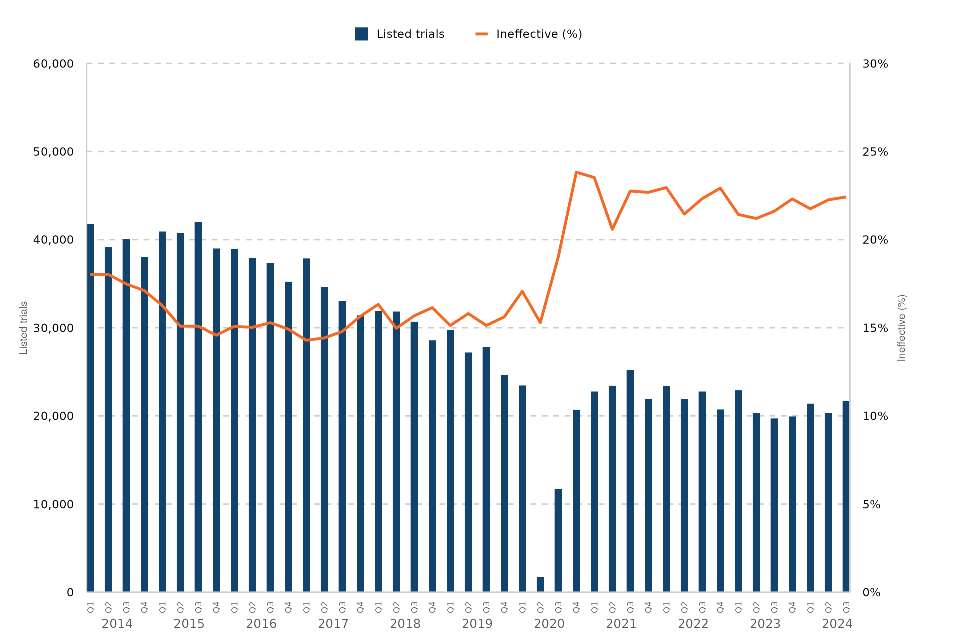
3. Criminal cases in the Crown Court
Continued increase in the open caseload at the Crown Court
Receipts continued to increase and reached a quarterly series peak. Disposal volumes have increased but they remain below receipts. As such the open caseload continued to increase to a new series peak of 73,105.
Consultation on “One Crown” changes to the Crown Court data processing
We have changed the way that we count some of the Crown Court statistics. There are a series of small methodological changes and data improvements which have been made to these estimates compared to the previously published methodology. The impact of these changes is small and does not affect the published trends.
Data concerning the Crown Court caseload (receipts, disposals and open cases) and open caseload durations are sourced from the “One Crown” methodology.
All other Crown Court series published here retain the existing published methodology and are released on a slightly different reporting basis. The data is still accurate and there are no significant concerns regarding the quality or validity of the data. We intend for all series to move to the “One Crown” methodology as we develop the wider series, which may lead to small revisions in future releases. The revised data is currently available back to 2016 – we will look to expand this back to cover the previously published timeseries back to 2014 in future releases of the statistics. Full details of the changes and the impact these have on previously published series can be found in the supporting technical guidance which is being released alongside the statistics: ‘Consultation on “One Crown” changes to the Crown Court data processing in Criminal Court statistics quarterly (CCSQ)’
Crown Court caseload (“One Crown”)
The increased throughput from the magistrates’ courts as part of the initial recovery from the pandemic response saw the volume of receipts at the Crown Court exceed pre-COVID levels in late 2020. Following a slight decline, receipts have tended to increase above levels seen immediately pre-COVID and the latest quarterly figure is the highest seen across the series.
There were 31,683 cases received into the Crown Court in Q3 2024, this is the highest quarterly value seen across the series since 2016. This represents a 4% increase on the previous quarter and 12% above levels seen in the previous year.
-
The increased demand at the Crown Court was seen equally in “for trial” and “sentence” cases, both up 13% on the previous year.
-
There were increases in receipts for all offence groups compared to the previous year, most notably a 35% increase in public order offences following the public disorder during the summer.
-
Violence against the person offences continue to be the largest contributing offence group with 9,206 receipts in the period – this represents an increase of 41% compared to Q3 2019 and now accounts for just under a third of all cases received in the quarter.
There were 29,502 cased disposed at the Crown Court in Q3 2024, this is the highest quarterly value seen since Q1 2017. The latest disposal volumes are up 5% on the previous quarter, 12% above levels seen in the previous year and well above levels seen in Q3 2019 (24,755).
-
The largest proportionate increase was seen for “sentence” cases which increased by 18% on the previous year, whereas “for trial” cases increased by 8%.
-
Increases in disposal volumes are seen for all offence groups (excluding drug offences) compared to the previous year. Similar to the trends in case receipts there has been a notable increase in public order offences and a consistent increase in violence against the person.
Figure 3: Crown Court caseload, Q1 2016 – Q3 2024 (Source: Table C1)
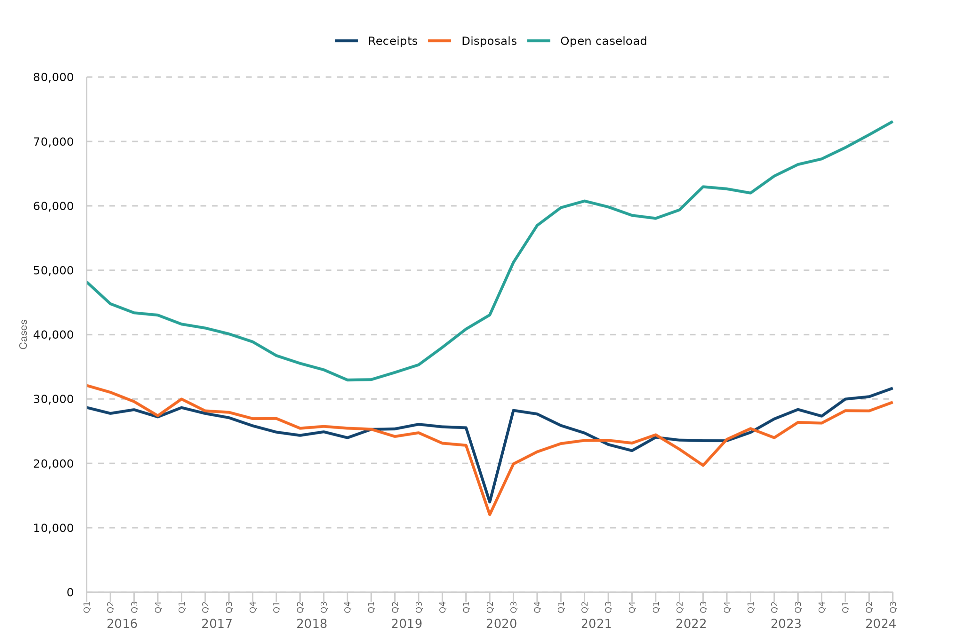
The open caseload reflects the workload in the courts at any time. It will never be zero, as it reflects the volume of cases that are active in the courts at a particular point, including those cases that have been recently received, those close to being disposed, those which are complex and take time to complete and those that may be delayed. The open caseload fell between 2016 and 2019, at the end of 2019 it stood at 38,016.
At the end of September 2024 there were 73,105 open cases at the Crown Court, this is a series high and continues increases seen since Q1 2023.
The open caseload increased 3% on the previous quarter (71,042 cases), 10% on the previous year (66,426 cases) and has close to doubled since the end of 2019 (38,016 cases).
-
The largest increase in the open caseload compared to the previous year were seen for violence against the person (21%), sexual offences (18%) and public order offences (14%).
-
The increases in open caseload volumes can be seen for all regions, with the South East reporting the largest open caseload at the end of September 2024 (15,985 cases).
The observed trends in public disorder offences broadly reflect the impact of the public disorder seen from July 2024. Further management information about the activity in the criminal courts following the public disorder is published by HMCTS. The HMCTS management information has been collated from data reported through from magistrates’ and Crown courts and covers all cases where the courts and prosecutors determine it to be related to the disturbances. The trends present in this release do not specifically identify cases determined to relate to the disturbances and instead just reflect the broader offence group “public disorder offences”.
Age of the open caseload at the – official statistics in development (“One Crown”)
The age of an open case is calculated from receipt at Crown Court to the end of the reporting period. The average age of an open case increased markedly from series lows in 2019 but both median and mean measures have fallen back from series peaks in 2021 and 2022.
In Q3 2024 the median age of all open cases was 157 days, down slightly from 159 in Q3 2023 but up markedly from 88 days in Q3 2019.
Figure 4: Average age of open cases at the Crown Court, Q1 2016 – Q3 2024 (Source: Table O1)
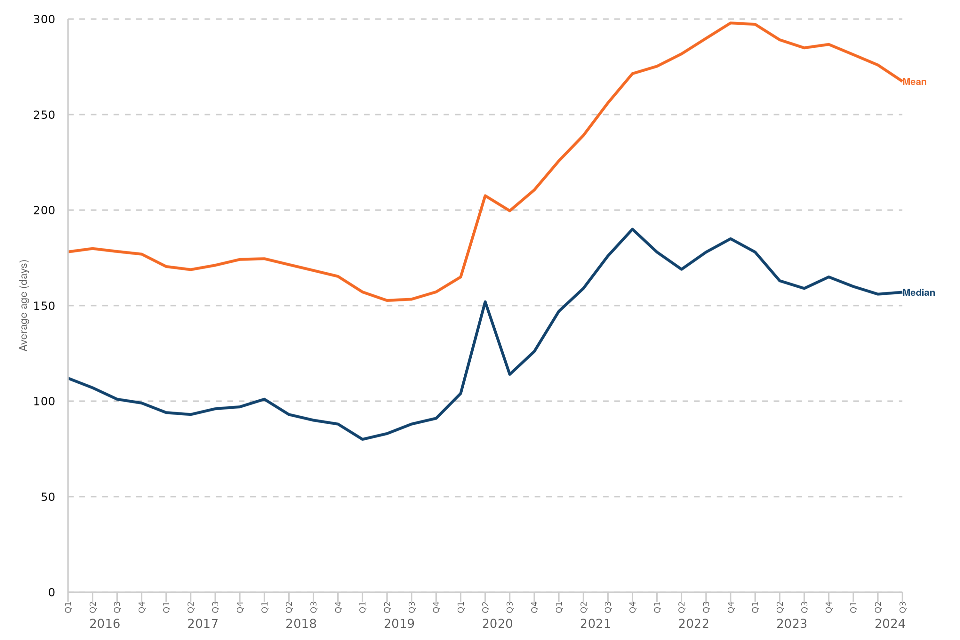
At the end of September 2024 there were 16,505 cases that had been open for a year or more – 1% less than a year ago (16,645). The number of cases open for a year or more has increased sharply since the pandemic and following a peak in September 2022 it has tended to fall slightly.
Figure 5: Proportion of open cases at the Crown Court by grouped age, Q1 2016 – Q3 2024 (Source: Table O3)
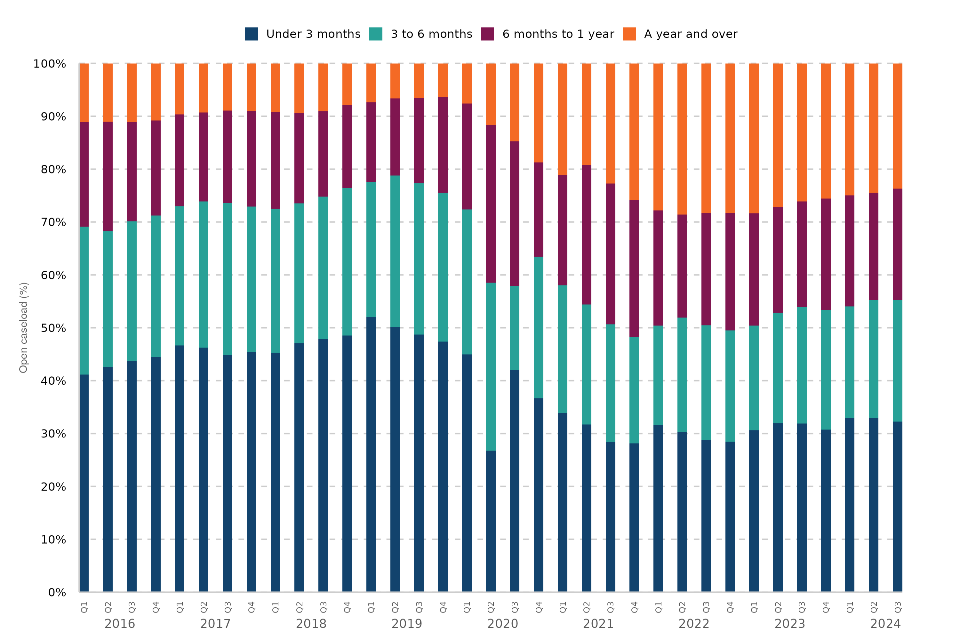
Trial efficiency at Crown Court
There were 7,640 trials listed to start in Q3 2024 - an increase of 2% on the previous quarter and 6% on the previous year – maintaining high levels last seen in 2018.
Figure 6: Crown Court listed trials and ineffective trial rate (%), Q1 2014 – Q3 2024 (Source: Table C2)
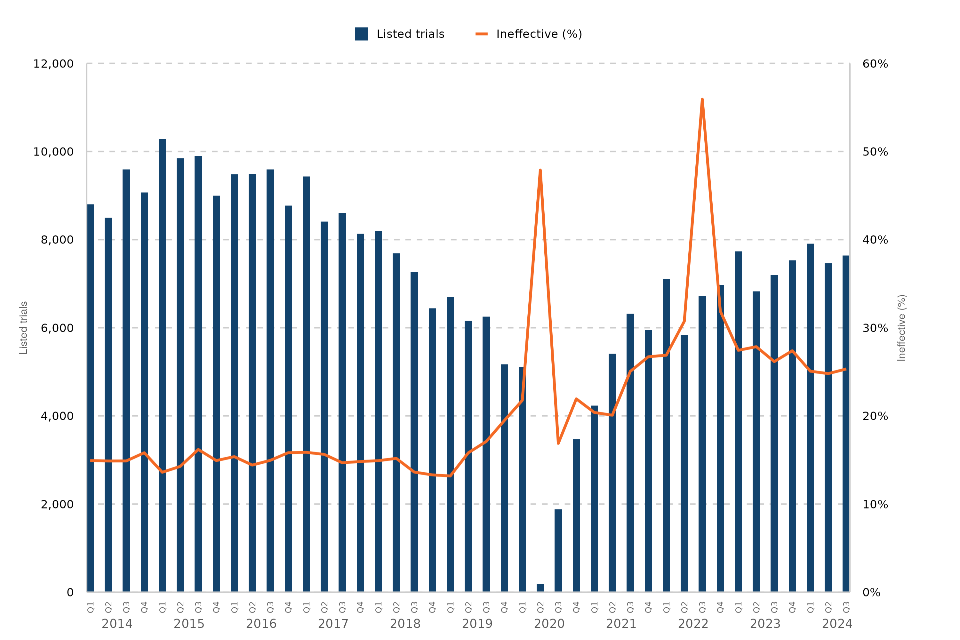
The proportion of trials which commence as planned (effective) remained stable at 43%, this has been fairly consistent for the last two years (excluding the impact of the CBA industrial action in Q3 2022) but it remains below rates seen pre-COVID which average around 50%.
Similarly, the percentage of trials that are not required (cracked) and which are rescheduled (ineffective) remained in line with the previous quarter (32% and 25% respectively).
There has been a step-change in the ineffective trial rate on levels seen prior to 2020 (ranging around 13-19%) and rates have stabilised at these higher levels.
Guilty plea rate
Guilty plea rate is the number of defendants in cases which have been disposed who entered a guilty plea to all counts as a proportion of all those who entered a plea.
The guilty plea rate increased sharply following the immediate COVID-19 response and the suspension of jury trials. More recently it has fallen back to pre-COVID levels as the volume of ‘not guilty plea’ cases being disposed of has increased. In Q3 2024 the guilty plea rate was 64%, broadly in line with levels seen since the start of 2023.
There were 3,698 defendants dealt with in Q3 2024 who entered a not guilty plea – down 5% on the previous quarter but up 9% on the previous year and above levels seen in Q3 2019 (3,226).
Average waiting time at the Crown Court
Waiting time is the duration between case receipt and first main hearing. The waiting time estimates are a ‘lagged’, backwards looking measure counted at the point of disposal. The median waiting time for defendants dealt with was 8.1 weeks in Q3 2024. This represents an 8% decrease on the previous year (8.9 weeks) but remains well above pre-COVID levels (5.0 weeks in Q3 2019).
Average hearing time at the Crown Court
The hearing time estimates are a ‘lagged’, backwards looking measure’ counted at the point of disposal. Hearing time is the duration of all hearings for a completed case. Both median and mean hearing times for all cases competed at the Crown Court have fallen on the previous year, down 9% and 5% respectively.
The median hearing time of ‘for trial’ cases where a not guilty plea was entered decreased by 8% on the previous year from 11.9 to 11.0 hours - the lowest reported value since 2017.
4. Timeliness
Timeliness has stabilised at the magistrates’ courts and fallen slightly at the Crown Court
The median time from offence to completion for cases completing at the Crown Court fell by 8% on the previous year to 355 days. Despite falls the latest estimate remains well above pre-COVID levels (253 days in Q3 2019).
The timeliness measures are based on defendants whose cases have been completed and as such are ‘backwards’ looking measures of timeliness between offence and completion at the relevant criminal court jurisdiction.
Single Justice Procedure timeliness
In the latest quarter there were 182,902 defendants dealt with at the magistrates’ courts via the Single Justice Procedure (SJP). This represents 64% of all defendants dealt with at the magistrates’ (excluding those sent on to Crown Court) and is down 6% on the volumes seen in the previous year.
The median duration from offence to completion for defendants dealt with via SJP was 189 days, a small increase on the previous year (183 days).
Magistrates’ courts timeliness
Timeliness at the magistrates’ courts measures the time from an offence being committed through key stages of the criminal justice system including charge, first listing and subsequent completion of a defendant’s case at the magistrates’ court.
Figure 7: Average number of days from offence to completion for defendants dealt with at the magistrates’ courts by stage, Q1 2014 – Q3 2024 (Source: Table T3)
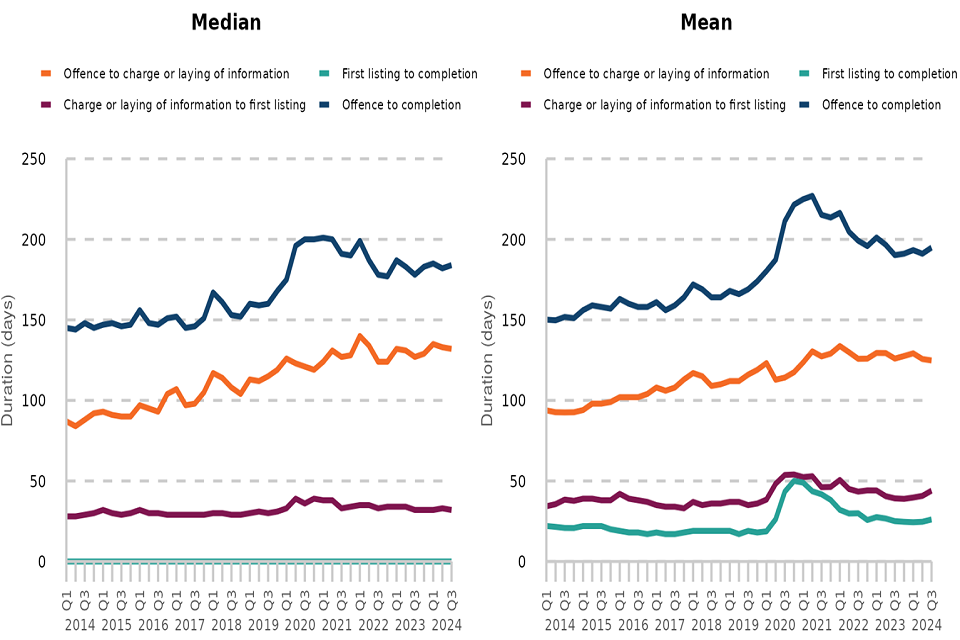
The median duration from offence to completion at the magistrates’ courts has stabilised following falls from series highs of around 200 days seen in late 2020 and early 2021. The latest quarterly estimates increased slightly on the previous year, from 178 days in Q3 2023 to 184 days in Q3 2024.
-
‘Pre-court’: the median time from ‘offence to charge’ fell slightly to 132 days, whilst time from ‘charge to first listing’ was unchanged on the previous quarter at 32 days.
-
‘At court’: the median estimate remained stable at 0 days, where the first listing and completion occur on the same day. The mean duration saw a slight increase to 26 days – this follows sharp increases seen over the COVID period and a peak of 50 days in Q4 2020.
Crown Court timeliness (“End-to-end”)
End-to-end timeliness measures the time from an offence being committed through key stages of the criminal justice system including charge, passage through the magistrates’ courts and subsequent completion of a defendant’s case at the Crown Court.
The estimates are created by linking magistrates’ courts and Crown Court data outputs to create an ‘end-to-end’ defendant journey across key stages of the criminal justice system.
The median duration from offence to completion for defendants dealt with at the Crown Court has fallen back from series highs – with a decrease of 8% from 384 days in Q3 2023 to 355 days in Q3 2024. The latest estimate remains well above pre-COVID levels (253 days in Q3 2019).
Figure 8: Median duration from receipt to completion in ‘for trial’ cases by plea at the Crown Court, Q1 2014 – Q4 2023 (Source: T4)
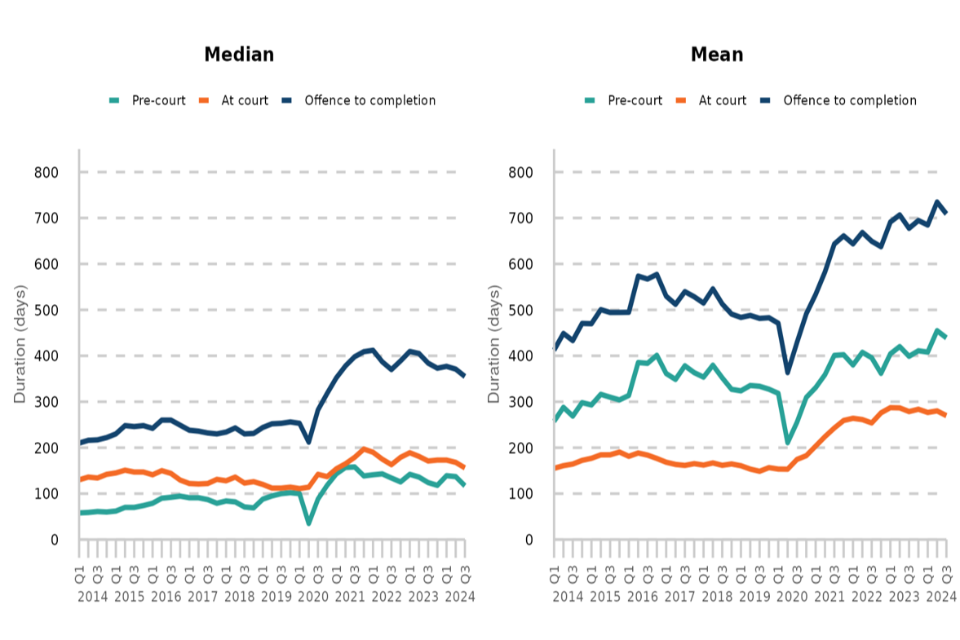
-
Pre-court’: the median time from ‘offence to first listing’ has tended fall back from a series peak in Q3 2021 (158 days) and the latest quarter continues this trend falling 6% on the previous year from 124 days to 117 days.
-
‘At court’: the median time from first listing at the magistrates’ courts to completion at the Crown Court continued to fall. The latest estimate (156 days) represents a 9% fall on the previous year (171 days) but remains well above levels seen pre-COVID (112 days in Q3 2019).
The median time from charge to completion for defendants dealt with at the Crown Court in Q3 2024 was 171 days. This has tended to fall back from peaks seen in 2021 and the latest estimate represents a fall of 4% on the previous quarter (179 days) and 7% on the previous year (183 days). Despite the falls, the latest estimate remains well above levels seen prior to 2020.
-
In ‘for trial’ cases where a not guilty plea was entered, the median duration from charge to completion was 451 days – this is down slightly on the previous quarter (from 462 days) but remains close to the series peak seen since 2021.
-
For guilty pleas the median duration was 170 days – this represents a fall of 6% on the previous quarter (180 days) and 9% on the previous year (186 days) but remain above levels seen prior to 2020.
5. Official statistics in development: Language interpreter and translation services
Completed language service requests rose on the previous quarter
There were 47,754 completed requests in Q3 2024, down slightly on the previous year and the success rate decreased by 6 percentage points on the previous year from 96% to 90%.
Completed service requests
The volume of completed service requests was 47,754, this has maintained the relatively high demand seen for interpreter and translation services since 2023 and represents a small fall (3%) on the previous quarter. The number of unfulfilled requests has increased sharply in the last two quarters and is more than double the levels seen in the previous year, increase from 1,676 to 3,722.
As a result of this increase, the overall success rate in Q3 2024 fell to 90% - this has decreased by 6 percentage points on the previous year.
The June 2024 booking portal update, aimed at improving responsiveness, caused unexpected issues, that although resolved quickly, temporarily impacted fulfilment rates.
Figure 9: Number of completed language service requests and overall success rate, Q1 2014 – Q3 2024 (Source: Table L1)
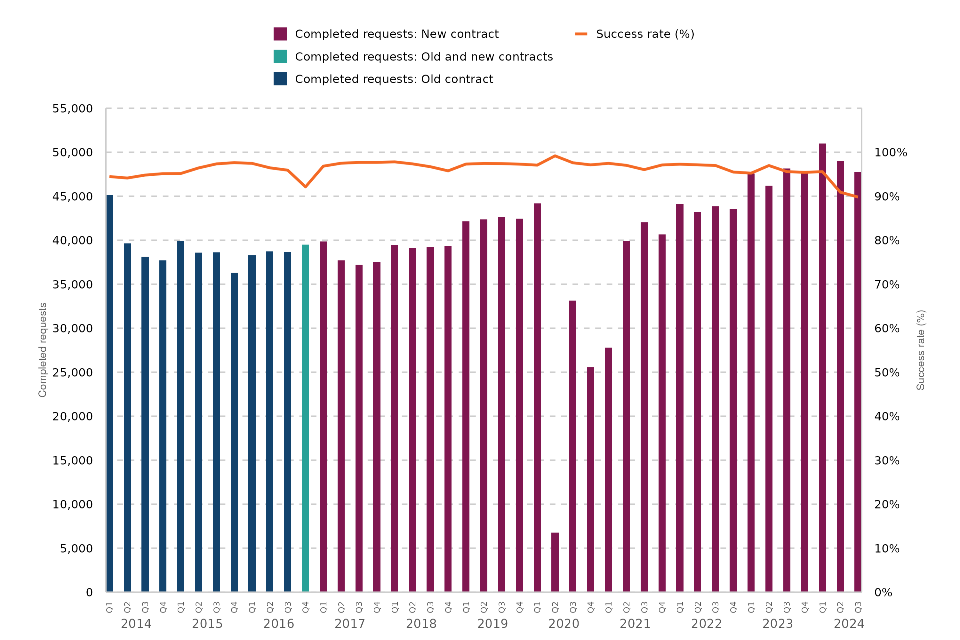
Complaints and complaint rate
The number of complaints has remained low since Q2 2020, with 248 complaints made in Q3 2024. This represents an increase of 70% on the previous year (146) but remains well below levels seen pre-COVID (507 complaints in Q3 2019). The overall complaint rate was 0.5% in the latest period and has remained below 1% since Q3 2020.
‘Off-contract’ requests
‘Off-contract’ requests are those which are procured outside of the contracted services where fulfilment cannot be achieved by the supplier. MoJ have undertaken a review of the off-contract data collection methods. Improvements to the collection have resulted in a more robust but higher baseline of activity than previously reported. This is considered a necessary change that improves data integrity and more accurately reflects the off-contract request volumes.
The development in this data series reflects the MoJ’s commitment to continuous improvement and best practice - ensuring more reliable insights into booking activity in future. The improved data is available from April 2024 currently and we will seek to revise the back series in future to reflect the improvements.
There were 4,030 ‘off-contract’ requests in Q3 2024, this represents an increase of 20% on the previous quarter (3,403).
6. Further information on criminal courts data
The data presented in this publication are from live administrative databases. Therefore, previously published data is liable to be updated in the latest bulletin, following any further data cleaning or the incorporation of additional cases not available in the extracts used to produce previous bulletins.
Accompanying files
As well as the bulletin, the following products are published as part of this release:
-
Technical guides providing background information and standalone quality guide.
-
A set of overview tables, covering each section of this bulletin.
-
Pivot tools and underlying data which feature further breakdowns of published data.
Accredited official statistics status
Accredited official statistics are called National Statistics in the Statistics and Registration Service Act 2007. These accredited official statistics were independently reviewed by the Office for Statistics Regulation (OSR) in January 2019[footnote 3]. They comply with the standards of trustworthiness, quality and value in the Code of Practice for Statistics and should be labelled as accredited official statistics. The OSR are currently undertaking a quality review on these statistics.
It is the Ministry of Justice’s responsibility to maintain compliance with the standards expected for accredited official statistics. If we become concerned about whether these statistics are still meeting the appropriate standards, we will discuss any concerns with the Authority promptly. Accredited official statistics status can be removed at any point when the highest standards are not maintained, and reinstated when standards are restored.
Official statistics in development status
Official statistics in development are official statistics that are undergoing a development; they may be new or existing statistics, and will be tested with users, in line with the standards of trustworthiness, quality, and value in the Code of Practice for Statistics. Until September 2023, they were called ‘experimental statistics’. Official statistics in development are developed under the guidance of the Head of Profession for Statistics (HoP). The goal is to develop statistics that can, in due course, be produced to the standards of the Code[footnote 4].
Contact
Press enquiries should be directed to the Ministry of Justice press office:
Tel: 020 3334 3536
Website: Media Enquiries
Other enquiries and feedback about these statistics should be directed to:
Email: criminal_court_sta@justice.gov.uk
Next update: 27th March 2025
URL: https://www.gov.uk/government/collections/criminal-court-statistics
© Crown copyright
Produced by the Ministry of Justice
Alternative formats are available on request from criminal_court_sta@justice.gov.uk
-
https://www.judiciary.uk/announcements/review-of-court-arrangements-due-to-covid-19-message-from-the-lord-chief-justice/ ↩
-
https://www.gov.uk/government/news/more-face-to-face-hearings-as-courts-reopen ↩
-
https://www.statisticsauthority.gov.uk/correspondence/compliance-check-on-court-statistics/ ↩
-
https://www.statisticsauthority.gov.uk/monitoring-and-assessment/code-of-practice/ ↩
